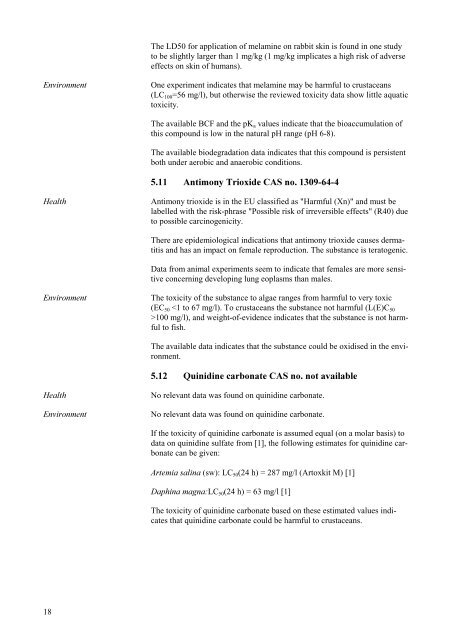Alternatives for Brominated Flame Retardants - Miljøstyrelsen
Alternatives for Brominated Flame Retardants - Miljøstyrelsen
Alternatives for Brominated Flame Retardants - Miljøstyrelsen
You also want an ePaper? Increase the reach of your titles
YUMPU automatically turns print PDFs into web optimized ePapers that Google loves.
The LD50 <strong>for</strong> application of melamine on rabbit skin is found in one study<br />
to be slightly larger than 1 mg/kg (1 mg/kg implicates a high risk of adverse<br />
effects on skin of humans).<br />
(QYLURQPHQW<br />
One experiment indicates that melamine may be harmful to crustaceans<br />
(LC 100 =56 mg/l), but otherwise the reviewed toxicity data show little aquatic<br />
toxicity.<br />
The available BCF and the pK a values indicate that the bioaccumulation of<br />
this compound is low in the natural pH range (pH 6-8).<br />
The available biodegradation data indicates that this compound is persistent<br />
both under aerobic and anaerobic conditions.<br />
<br />
$QWLPRQ\7ULR[LGH&$6QR<br />
+HDOWK<br />
Antimony trioxide is in the EU classified as "Harmful (Xn)" and must be<br />
labelled with the risk-phrase "Possible risk of irreversible effects" (R40) due<br />
to possible carcinogenicity.<br />
There are epidemiological indications that antimony trioxide causes dermatitis<br />
and has an impact on female reproduction. The substance is teratogenic.<br />
Data from animal experiments seem to indicate that females are more sensitive<br />
concerning developing lung eoplasms than males.<br />
(QYLURQPHQW<br />
The toxicity of the substance to algae ranges from harmful to very toxic<br />
(EC 50 100 mg/l), and weight-of-evidence indicates that the substance is not harmful<br />
to fish.<br />
The available data indicates that the substance could be oxidised in the environment.<br />
<br />
4XLQLGLQHFDUERQDWH&$6QRQRWDYDLODEOH<br />
+HDOWK<br />
(QYLURQPHQW<br />
No relevant data was found on quinidine carbonate.<br />
No relevant data was found on quinidine carbonate.<br />
If the toxicity of quinidine carbonate is assumed equal (on a molar basis) to<br />
data on quinidine sulfate from [1], the following estimates <strong>for</strong> quinidine carbonate<br />
can be given:<br />
$UWHPLDVDOLQD(sw): LC 50 (24 h) = 287 mg/l (Artoxkit M) [1]<br />
'DSKLQDPDJQDLC 50 (24 h) = 63 mg/l [1]<br />
The toxicity of quinidine carbonate based on these estimated values indicates<br />
that quinidine carbonate could be harmful to crustaceans.<br />
18

















